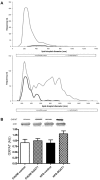Paradoxical increase in TAG and DAG content parallel the insulin sensitizing effect of unilateral DGAT1 overexpression in rat skeletal muscle
- PMID: 21264296
- PMCID: PMC3021516
- DOI: 10.1371/journal.pone.0014503
Paradoxical increase in TAG and DAG content parallel the insulin sensitizing effect of unilateral DGAT1 overexpression in rat skeletal muscle
Abstract
Background: The involvement of muscle triacylglycerol (TAG) storage in the onset of insulin resistance is questioned and the attention has shifted towards inhibition of insulin signalling by the lipid intermediate diacylglycerol (DAG). The enzyme 1,2-acylCoA:diacylglyceroltransferase-1 (DGAT1) esterifies a fatty acyl-CoA on DAG to form TAG. Therefore, the aim of the present study was to investigate if unilateral overexpression of DGAT1 in adult rat Tibialis anterior (TA) muscle will increase conversion of the lipid intermediate DAG into TAG, thereby improving muscle insulin sensitivity.
Methodology/principal findings: The DGAT1 gene construct was injected in the left TA muscle of male rats on chow or high-fat (45% kcal) diet for three weeks, followed by application of one 800 V/cm and four 80 V/cm pulses, using the contralateral leg as sham-electroporated control. Seven days after electroporation, muscle specific insulin sensitivity was assessed with a hyperinsulinemic euglycemic clamp using 2-deoxy-[3H]glucose. Here, we provide evidence that unilateral overexpression of DGAT1 in TA muscle of male rats is associated with an increased rather than decreased DAG content. Strikingly, this increase in DAG content was accompanied by improved muscle insulin sensitivity. Interestingly, markers of muscle lipolysis and mitochondrial function were also increased in DGAT1 overexpressing muscle.
Conclusions/significance: We conclude that unilateral DGAT1 overexpression can rescue insulin sensitivity, possibly by increasing DAG and TAG turnover in skeletal muscle. In case of a proper balance between the supply and oxidation of fatty acids in skeletal muscle, the lipid intermediate DAG may not exert harmful effects on insulin signalling.
Conflict of interest statement
Figures







References
-
- Boden G, Lebed B, Schatz M, Homko C, Lemieux S. Effects of acute changes of plasma free fatty acids on intramyocellular fat content and insulin resistance in healthy subjects. Diabetes. 2001;50:1612–1617. - PubMed
-
- Bachmann OP, Dahl DB, Brechtel K, Machann J, Haap M, et al. Effects of intravenous and dietary lipid challenge on intramyocellular lipid content and the relation with insulin sensitivity in humans. Diabetes. 2001;50:2579–2584. - PubMed
-
- Phillips DI, Caddy S, Ilic V, Fielding BA, Frayn KN, et al. Intramuscular triglyceride and muscle insulin sensitivity: evidence for a relationship in nondiabetic subjects. Metabolism. 1996;45:947–950. - PubMed
-
- Pan DA, Lillioja S, Kriketos AD, Milner MR, Baur LA, et al. Skeletal muscle triglyceride levels are inversely related to insulin action. Diabetes. 1997;46:983–988. - PubMed
-
- Perseghin G, Scifo P, De Cobelli F, Pagliato E, Battezzati A, et al. Intramyocellular triglyceride content is a determinant of in vivo insulin resistance in humans: a 1H-13C nuclear magnetic resonance spectroscopy assessment in offspring of type 2 diabetic parents. Diabetes. 1999;48:1600–1606. - PubMed
Publication types
MeSH terms
Substances
LinkOut - more resources
Full Text Sources
Medical

